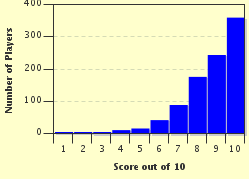Quiz Answer Key and Fun Facts
1. Sir Isaac Newton, undoubtedly one of the greatest scientists of all time, was renowned for his research on gravity, supposedly from observing that falling apple. However, for which other major scientific advances is he also at least partially responsible?
2. This talented physicist and chemist made many discoveries regarding magnetism and electricity during the first half of the nineteenth century. One of the most far-reaching developments was his development of a motor powered by electromagnetic fields. Who is this man who has the unit of capacitance named in his honor?
3. Despite being published in 1859, the theory regarding evolution arising from natural selection remains highly controversial in the public arena in the US today. Which Englishman developed his ideas leading to this theory during his voyages on HMS Beagle?
4. The 'Photoelectric Effect' describes how an electric current can be generated by intense light shining on a metal surface. These experiments created an apparent paradox between particle and wave theories of light. One man solved this paradox in 1905 by showing how light (photons) occurred in discrete quanta which led to him ultimately receiving the 1921 Nobel Prize in Physics. Who is this most famous scientist of the twentieth century, who died in 1955 after spending the last part of his working life at the Institute for Advanced Study in Princeton?
5. The nineteenth century French chemist and microbiologist Louis Pasteur has rightly received huge commendation for his pioneering work in preventing disease. His name is captured in the common practice of treating milk to keep it safe for drinking. What major experimental breakthrough did he make towards improving human health as a whole?
6. Some great discoveries occur by accident, but also involve careful observation and thought to determine what the surprising results signify. In 1928, Scottish scientist Alexander Fleming was investigating the properties of staphylococci bacteria. Prior to going on holiday he stacked all the cultures in a corner of his untidy laboratory. On returning several weeks later, he noticed a fungus had grown in one dish and that culture was dead. What had he just discovered?
7. Carl Linnaeus, an 18th century Swedish scientist, is known as the 'Father of Taxonomy' for his biological classification methodology. What important contribution did he make?
8. In 1915, German scientist Alfred Wegener proposed that the earth's crust slowly moves over a liquid core. As part of this work, he hypothesized that 200 million years ago there was a single, super continent, Pangaea, which eventually separated into two smaller super continents, Laurasia and Gondwanaland, which in turn separated into the continents we know today. What name was given to this theory which was originally ridiculed by Wegener's peers?
9. The Russian scientist Dmitri Mendeleev is most famous for organizing what information in 1869?
10. This research was carried out by a large multinational team, commencing in 1990 and finishing in 2003, although a lot of work is continuing and will do so for decades to come. What was 'mapped' during this project which has enormous potential to help us understand human development and disease (and much more)?
Source: Author
MikeMaster99
This quiz was reviewed by FunTrivia editor
bloomsby before going online.
Any errors found in FunTrivia content are routinely corrected through our feedback system.

